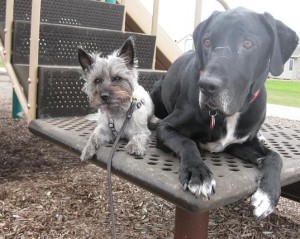
"Don't worry. He's good with other dogs."
I'm sure you've heard that statement before. But some dog owners forget that just because a dog is good with one dog doesn't mean he's good with all dogs. Sometimes certain personalities or energy levels don't mix. This post includes some safety reminders on
How to introduce two dogs for a walk or playdate.
1. Prevent direct eye contact between the dogs.
Some dogs try to put their faces right up to other dogs. This can be OK for dogs that already know each other, but other dogs might find it threatening or rude. To prevent head-on greetings, you can briefly walk the dogs side by side or walk one right in front of the other. Sometimes it's effective to quickly step between the two dogs or to distract them by calling their names.
2. Take the dogs for a walk together.
If possible, take the dogs for a walk together, even if it's just around the block. This will give them time to get acquainted without the pressure of interacting. Keep the dogs parallel to one another, and keep a human between them if necessary. Praise the dogs for calm, loose body language and distract them if there is any tension. Make sure the dogs are wearing well-fitted dog collars with identification tags.
3. Avoid tension.
It's important to encourage the dogs to remain relaxed, but it's just as important for the humans to stay relaxed. Tightly gripping the leashes will only add tension for the dogs. Instead, keep the leashes loose, and keep your body posture relaxed. If needed, distract the dogs by whistling or talking to them. It's also effective to use a toy, but don't let the dogs play with toys right away in case there are possessiveness issues.
4. Let the dogs play in a fenced area.
Once the dogs have walked around a bit and had a chance to sniff each other and burn off some initial energy, you might be comfortable letting them play in a fenced area. If they don't seem ready for this, quit while you're ahead and schedule another walk for another day. You want to make sure to keep setting the dogs up for success. Don't push them too far.
If you do decide to let the dogs play, it's better to let them play outside where there is more space rather than indoors. If you're worried about how the dogs will get along, it's OK to leave their leashes on for the first few minutes. It's a good idea to use quick-release buckle collars as a safety precaution in case the dogs get their leashes or collars tangled up during play.
5. Intervene before play escalates.
It's natural for dogs to show a lot of excitement when they play. The dogs might run, wrestle, bark and growl. This is all normal, but it's a good idea to distract the dogs when the playing becomes extra rowdy. It's too easy for play to escalate to fights. So, until the dogs are comfortable with one another, distract them every few minutes by calling their names, asking them to sit or giving them treats.
What are your ideas for successfully introducing dogs?

